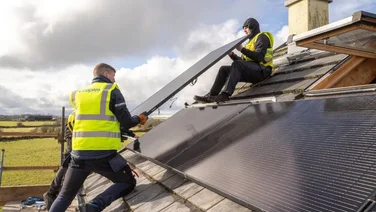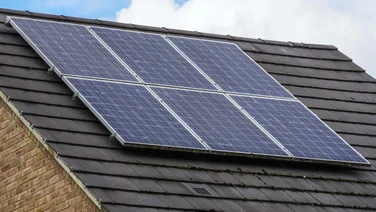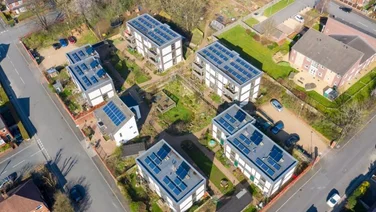✔ Renewable energy is the future, and fossil fuels don’t have long left
✔ This guide will give you the lowdown on the pros and cons of both
✔ Fill in the form above to receive solar panel quotes
DISCLAIMER: Our partners no longer take appointments for homeowners looking to benefit from the Feed-in Tariff, which concluded on 31st March 2019
Goodbye, oil. Farewell, natural gas. So long and don’t bother to write, coal. The world is increasingly patting fossil fuels on the back, then sending them off to the great sooty place in the sky. With the cost of solar panels, wind energy, and hydropower falling, this is the turning point.
As humans face up to the catastrophic consequences of climate change, people have finally woken up to the desperate need to banish these dangerous energy sources in favour of renewable energy.
More people are harnessing renewable energy at home, businesses are looking for greener ways to power offices, and governments are findings ways to ditch fossil fuels. As a result, renewables are becoming more affordable. In fact, the price of solar panels has decreased by 82% since 2010. The price of electricity generated from renewables has also become more competitive with that from fossil fuels, making the switch to greener energy sources more economically viable.
But how do fossil fuels and renewables compare? Let’s take a look.
Where do you want to install solar panels?
Get started
What’s on this page?
Head straight to a specific section by clicking the links below.
- 01 | What is renewable energy?
- 02 | Renewable energy sources
- 03 | What are fossil fuels?
- 04 | Non-renewable energy sources
- 05 | What is the importance of renewable energy?
- 06 | Pros and cons of renewable energy
- 07 | Pros and cons of fossil fuels
- 08 | Renewable energy vs fossil fuels
- 09 | Summary
So far, 185 countries have signed the 2016 Paris Agreement, and the results have been clear. Governments all over the world have taken more and more actions to cut their fossil fuel usage to meet (or even exceed) the treaty’s requirements. One consequence is that one third of global power capacity is now based on renewable energy, according to a report in April 2019 from the International Renewable Energy Agency – and that’s only the start.
France, Britain, and Germany (among others) have committed to getting rid of all their coal-fired plants by 2021, 2025, and 2038 respectively. An article in The Financial Times in 2019 questioned the value of coal power by asking: “Why invest in capacity that has a 20-year lifespan at most?” It’s a good question.
The amount of renewable energy produced in the European Union increased by two thirds between 2007 and 2017, while consumption more than doubled between 2004 and 2017. Clearly, renewable energy is on the rise.
The list goes on, with Costa Rica’s president stating his country would stop using fossil fuels by 2050, Norway instituting a ban on the sale of petrol and diesel-powered cars by 2025, and the Netherlands doing the same by 2030. Furthermore, since the start of 2017, Dutch national rail network trains have been completely powered by renewable energy.
Over in the US, Nevada, California, Hawaii, New Mexico, and Puerto Rico have all committed to using only renewable energy by 2050, along with more than 100 cities and towns across the country. This switch makes economic sense, too, as 74% of American coal production now costs more to produce than solar and wind energy, according to a 2019 study by renewables analysis firm Energy Innovation. By 2025, this figure is estimated to rise to 86%.
Coal in particular is dropping off the face of the energy map, generating just 5% of the UK’s power in 2018. The British government reported at the end of the year that the output from bioenergy, waste, wind, solar, and hydro was around 13 times higher than coal. For more than two weeks in summer 2019, Britain didn’t use any coal to generate electricity – the longest such period since 1882.
Fossil fuels are disappearing, while renewable sources rise to prominence. But let’s slow down and answer some commonly asked questions. For instance, what exactly is renewable energy? What’s the importance of renewable energy? And how do you define non-renewable energy sources? Read on to discover the answers to all your questions.
According to NASA, humans have increased atmospheric CO₂ concentration by more than a third since the Industrial Revolution began. You can help to stop the rot by getting solar panels. Simply fill in this quick form to receive free solar panel quotes.
What is renewable energy?
Renewable energy is any energy which comes from a source that regenerates on a human timescale (a matter of minutes or months, rather than millions of years) and produces minimal emissions that contribute to climate change. Natural phenomena like the sun, wind, water, and natural heat stored in the Earth (known as geothermal energy) are prime examples of renewable energy.
Simply put, renewable energy is the future.
Renewable energy sources
Wind power: Air flow moves wind turbines, creating mechanical power from kinetic energy, which a generator then converts into electricity.
Solar power: Energy from the sun’s light is converted into electricity.
Hydro power: Energy derived from the fast flow of water, generally through spinning a turbine, which a generator can then convert into electricity.
Tidal power: Using the movements of the tides to generate electricity.
Geothermal energy: This is thermal energy derived from deep in the Earth, coming from radioactive decay and the continual heat loss which began when the planet was formed.
Ambient heat captured by heat pumps: Pumps take heat from the air or ground and use it to heat a building.
Biofuels: Fuel made with crops or biological waste.
Waste: This involves turning non-biological waste into energy, usually through burning it.

Where do you want to install solar panels?
Get startedWhat are fossil fuels?
Fossil fuels are non-renewable energy sources, namely coal, oil, and natural gas. They were created tens or hundreds of millions of years ago, when plants and animals were buried and compressed into kerogen. This mineral, which contains 10,000 times more organic matter than any living being, is the basis for all fossil fuels.
Over the course of millions of years, geothermal heat turns kerogen into one of coal, crude oil, or natural gas.
Fossil fuels still make up around 80% of the world’s energy consumption, but are considered non-renewable since it takes such a long time to produce them. As well as their effectively finite nature, they’re also being phased out because of their negative effects on the Earth’s climate. According to NASA, humans have increased atmospheric CO₂ concentration by more than a third since the Industrial Revolution began.
Non-renewable energy sources
Coal: A carbon-rich substance which comes from dead plants decaying, turning into peat, and being converted through millions of years of heat and pressure into coal. It is extracted from inside the Earth and burned for energy. In 2011, coal plants produced 14.4 billion tons of CO2.
Crude oil: This is created when lots of tiny dead animals are buried and exposed to intense heat and pressure over millions of years. Like coal, it is then burned for energy. Crude oil can be turned into refined petroleum, kerosene, orimulsion, and propane.
Natural gas: This is made from layers of decaying animals and plants being subjected to intense heat and pressure for millions of years. It is then burned for energy.
What is the importance of renewable energy?
Renewable energy sources will help to slow down and prevent the worst consequences of climate change. In effect, they can help save the world from the destructive practices humans have undertaken since the Industrial Revolution began more than two centuries ago.
NASA has reported that the intensity, frequency, and duration of North Atlantic hurricanes “have all increased since the early 1980s”, and that “storm intensity and rainfall rates are projected to increase as the climate continues to warm.”
The organisation has also predicted that “in the next several decades, storm surges and high tides could combine with sea level rise and land subsidence to further increase flooding in many regions.”
The World Wide Fund for Nature has stated that climate change is “likely to be the greatest cause of species extinctions this century”. This has been highlighted by a United Nations body’s report which claims a 1.5°C average rise may put 20-30% of species at risk of extinction.
“If the planet warms by more than 2°C, most ecosystems will struggle.”
Even more worryingly, a 2017 University of Washington study based on the data in this UN report found there was a 90% chance this would happen – so it’s past time that we embrace renewable energy.
Non-renewable energy sources are also finite, meaning that at some point in the next century or so, they will run out – leaving us with a huge power deficit. If we’re going to carry on powering everything from your smartphone and the lights in your home to planes, trains and automobiles, we need renewable energy sources.
Soon, alternative energy won’t just be the better option; it’ll be the only option. And if you want to embrace the savings which going green can bring you, fill in this helpful form.
Green energy sources can also offer more affordable energy bills for people worldwide – especially since renewables are now cheaper than fossil fuels.
Pros and cons of renewable energy
- Will help to save human and animal lives
- Will stop deadly pollution
- Stable energy prices
- A practically endless supply
- Job creation
- Lower running costs
- Can be produced on a smaller scale
- If a solar panel or wind turbine malfunctions, it doesn’t lead to mass deaths or illnesses
- Some types are currently more expensive
- Inconvenient to overhaul the energy sector
- Can require larger areas of land
- Some rely heavily on a climate that’s changing
- Staff would need to be retrained or replaced
Information updated in July 2019.
Pros and cons of fossil fuels
- The infrastructure is already in place
- They’re cheaper in some cases
- They don’t require as much land
- The sector employs millions around the globe
- They can be produced whatever the weather
- It’s convenient to maintain the status quo
- Their continued large-scale use is producing climate change that endangers humans, animals, and the Earth
- Air pollution resulting from coal kills 800,000 people per year
- Their locations disproportionately benefit the small number of countries where they are
- Jobs are falling, and are generally much less safe long-term than roles in the renewable energy sector
- Fossil fuel disasters are considerably worse – oil spills, oil fires, coal mining disasters, gas explosions, and mass poisonings can all kill or infect on a large scale
- They’re finite, and will run out in the next century or so
- As the supply runs out, it may lead to economic, political, and social tensions within nations and between different countries
- The fossil fuel industry produced 37.1 billion tonnes of global CO2 emissions in 2018
Information updated in July 2019.
Renewable energy vs fossil fuels
There really is no competition between the two categories of energy sources available to us. One is currently polluting the planet, and causing the climate to change in ways that will harm us and most species on Earth – while the other is clean, renewable, and infinite.
According to NASA, the ways in which we use fossil fuels as energy sources will lead directly to a variety of disastrous repercussions. For starters, we will have to deal with even more frequent wildfires, droughts and heat waves. By 2100, extremely hot days which previously happened once every 20 years will occur every two or three years.
Hurricanes will become stronger, longer, and generally more terrifying. A 2018 study published in scientific journal Nature predicted that climate change could increase rainfall totals for the worst hurricanes and cyclones by up to 30%. A different study in the American Meteorological Society journal also projected up to an 87% rise in the frequency of the most extreme hurricanes.
NASA expects sea levels to rise between one and four feet by 2100, and has pointed out that small islands like the Pacific nation of Tuvalu could be entirely submerged as a result. The UN has stated that a sea level rise of just 0.5m could displace a total of 1.2 million people from low-lying islands in the Caribbean Sea, Indian Ocean, and Pacific Ocean.
There’s really no way to overstate the danger which climate change poses to these countries, or how much non-renewable energy sources contribute to the phenomenon. In 2017, Marshall Islands environment minister David Paul summed it up nicely when he told The Guardian: “I can’t stress enough that coal is by far the largest single barrier to staying within 1.5C of warming, and giving vulnerable countries like mine a chance of survival.”

And it’s not just tiny islands that’ll be affected. A 2017 UN report found that 40% of the world’s population lives within 100km of a coastline. That’s more than three billion people. Rising sea levels will affect everyone, forcing people on the coast inland, and potentially leading to overcrowding and resource scarcity.
That’s not even factoring in the damage which rising sea levels could cause to harbours and ports, which the UN has estimated could be as high as £89 billion by 2050 and $293 billion by the end of the century.
In contrast, renewable energy sources are better for your health. They don’t cause climate change, and generally have a minimal effect on the environment.
They’ve already taken over 22% of the world’s electrical power production, and created 11 million jobs (despite many countries like the UK, France, and the Netherlands still giving more in subsidies to the fossil fuel industry than renewable energy producers). And best of all, they’ve managed this without melting any polar ice caps or increasing the frequency of hurricanes or wildfires.
Renewable energy sources also have the potential to act as a great equaliser in terms of energy production. Historically, a country has had to be blessed with oil, coal, and/or natural gas to be able to supply its own energy and sell it abroad. While a renewable future will still favour certain nations – namely those with abundant sunshine, wind, water, and geothermal energy – there will be more ways for nations to develop their energy industries.
Traditionally poorer countries like Mozambique, Tajikistan, and Kyrgyzstan have already made moves towards a future fully powered by renewable energy. This could mean being able to avoid an overreliance on getting energy from global forces like Saudi Arabia, China, and Russia – and could even lead them to develop their economies by exporting renewable energy.
For instance, as of 2016, Ethiopia derived 93% of its energy from renewable sources – and a new, multi-billion-pound geothermal project may provide further opportunities to boost the nation’s economy.
As well as being easier for different countries to produce, renewable energy is also becoming cheaper than fossil fuels. According to a 2018 International Renewable Energy Agency report, out of all the global energy production centres due to be commissioned in 2020, “over three-quarters of the onshore wind capacity and four-fifths of the solar PV project capacity… should produce cheaper electricity than any coal, oil, or natural gas option.”
Summary
We’ve reached the tipping point.
It’s been known for years that fossil fuels are hurting the planet we live on, endangering animals and humans alike. But now, finally, renewable energy makes sense on a financial as well as a moral level.
And it’s not just hypothetically possible to power whole countries with renewable energy; it’s already been done. Albania, Lesotho, Nepal, and Paraguay have proved this fact, while nations like Iceland and Costa Rica have also come close to 100%.
Renewable energy sources are less catastrophic than fossil fuels, both in their effect on the climate and in terms of how few disasters – like oil spills and gas fires – they produce.
But despite all of these facts, it’s proving difficult to convince countries to use more renewable energy when they’re trying to develop their economies as quickly as possible. 2018 saw a 2% rise in CO2 emissions – the largest increase in seven years, according to oil and gas company BP, and one which took CO2 levels to a record high.
And some of the main offenders are the nations with the biggest economies in the world. For example, the US accounted for almost all of the 2.4% global increase in oil production, and nearly half of the rise in global natural gas production.
It’s up to you to decide whether you want to be part of the renewable revolution, or would rather turn a blind eye.
It may also help you to sell your home one day, as 69% of people are likely or very likely to buy or rent a property with solar panels, according to our latest National Home Energy Survey.
So if you’d like to see how much plumping for solar energy could save you, you can get a quick quote here, and save both money and your planet in the long term.





